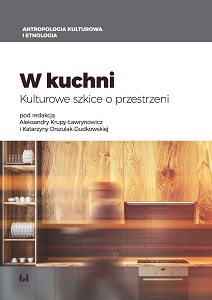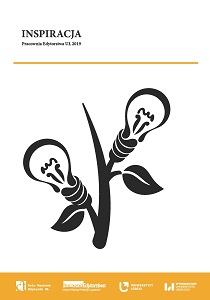
We kindly inform you that, as long as the subject affiliation of our 300.000+ articles is in progress, you might get unsufficient or no results on your third level or second level search. In this case, please broaden your search criteria.






The authors present the idea of a publication entitled In the Kitchen. Cultural Sketches about Space. They assume that the kitchen is a room associated with many cultural and social meanings. It is primarily an inalienable part of the home, private, inhabited space that can be variously designated, organized and experienced. The kitchen usually performs activities and processes related to meal planning, storage and processing of products as well as preparation and consumption of food. There are various practices inherent in the cultural reflection on lifestyles, corporality and gender, which are an emanation of social change and an attempt to (re)define tradition and identity. The space of the kitchen is a subject to fashions, trends and ideologies, aesthetic and economic rules. The authors, along with other researchers in this publication, do not present a consistent history of changes that affect the kitchen. They try to show a space full of meanings on selected examples, reaching to different cultural and social contexts.
More...
The aim of this writing is to indicate the possibility of cooperation between anthropologists who are interested in researching everyday life of a human with specialists on design based on house space design. The author refers to a strand of design anthropology whose aim is to demonstrate diversity and complexity of life of people in different social contexts to designers. Thanks to that they can design objects and services which meet customers’ needs better. In this writing, the author presents the results of ethnographic researches related to a contemporary kitchen space. Those researches were inspired by design anthropology and revealed detailed ways of using kitchen spaces, descriptions of their arrangements and equipment as well as everyday activities that happened in therein. Research results show a contemporary kitchen as a place with a potential, as a profusely equipped multitasking workshop which is open to many creative activities, not only culinary ones. They provide the knowledge about behaviours of so-called ordinary people which are a resultant of a tradition, current identity choices and a wide range of grassroots – individual and group – preferences and habits which can be useful not only for settlement culture researchers as well as for designers and producers of various objects and services.
More...
In the article author shows how the significance of the kitchen has changed and what cultural and symbolic factors influenced that in modern home’s “geography” this space was marginalized. Author poses questions about the sustainability of some figures of imagination, which determined the spatial hierarchy in the home. Analyzing old-time architectural guides and treatises as well as contemporary magazines and websites devoted to interior design, author tries to show these changes and a new spatial and cultural dimension of kitchen.
More...
The article is an attempt of anthropological reading of architectural projections of single-family houses in Poland A.D. 1994 (a catalog of the „Inwestprojekt” Center in Warsaw). The main subject of reflection is the spatial relations between kitchen and living room as the reverse of social and cultural patterns of home space organization placed on a continuum: open kitchen – closed kitchen.
More...
The article applies to cooking and eating, which also belong to the scope of social assistance, provided to people experiencing homelessness or at risk of homelessness. Food and kitchen facilities are marked by the status of their users and recipients. People who can almost exclusively rely on outside help eat either what they can get from others (by begging, by searching the rubbish bins) or what they receive from others (all forms of official and voluntary food supply). Products that are used to prepare meals, as well as the manner and place of their preparation, consumption or issuance, are marked by people who use this form of help. The more so because this kind of feeding is subject to many restrictions included, among others in laws, regulations and other state guidelines and in internal institutional regulations. In this context, the kitchen appears primarily as a practice securing the biological possibility of survival and satisfying hunger. However, you can also find examples when eating practices provide emotional and social support. The symbol of solidarity may be a meal offered by Food not Bombs or a kitchen – a common place, where “sharing yourself”, sharing emotions, and not just eating. The author shows the diversity of attitudes towards the kitchen, food and as nutrition, drawing examples from her own field research, conducted in 2009 in Lodz institutions specializing in helping people experiencing homelessness or being at risk.
More...
The pattern of home kitchen to which the first French restaurants turned out became anachronic in the face of the increase of catering properties in 19th century and the need to prepare meals on a massive scale. Return to systems similar to home kitchen but used in catering was implemented during First World War canteen projects. A similar one was realized in the 1920s in Soviet Union but in this case the development of collective kitchens had to implement the ideological plan of home kitchen degradation. Discrediting homemade food for meals in canteens was to attempt and abandonment of time consuming cook of small portions prepared at home according to traditional recipes. The project of canteens development on massive scale took place in Poland since the beginning of 1950’s. Referring to the Soviet patterns mechanized kitchens, using semi-prepared meals and producing standardized dishes reasonably turned out to be in practice an unfulfilled utopia. Slogans of kitchen modernization in Poland during the first two decades of communist regime should be considered as ideological postulate that greatly remained in the sphere of unrealized project actually suited “higher” meaning the practices of institutionalization – through attempts of rationalization and control of everyday life practices.
More...
The lack of a room in the architectural block of a house that would serve the function of a kitchen – a feature of unicameral housing built for workers before World War II. Only the collected and spaced out equipment and objects established the landscape of the kitchen (people and objects), in which the residents cooperated and which “evoked” certain interactive responses from the human side. In the article, from the perspective of residential habitation, I look at objects and their structuring within a fragment of the space of a flat called a kitchen. I rely on the material collected during many years of research on the interior of housing for workers’ families, which I conducted with students of ethnology at the turn of the seventies and eighties of the twentieth century in Lodz, among residents of tenement houses and family homes built by manufacturers for “their” workers. Among the collected accounts, I choose the ones that the workers who deal with the families lived in the same apartments before and after the war, because I want to look at living as a practice that connects with generational staying in a certain space and passing patterns of her domestication.
More...
The kitchen for 150 years has fundamentally changed. It related both in space and its functions for the household. First part of the text included description of the transformation Lublin kitchen, which primary was only a part of a room, near the stove and since the 1920s became a separate room. The following describes how this room was used and what were and still are its functions for users (culinary, economic, leisure, hygienic, sacral, ritual and integrative). In spite of these changes, the kitchen remained the most conducive place in the home, where most of the tasks indispensable for the proper functioning of the family are realized.
More...
Makatka, an ordinary piece of linen with an embroidered straight contour drawing, often with a sentence or an inscription. Who among us has not met at least once with this, generally considered to be kitschy, subject? Fashion for tapestries lasted from the mid-nineteenth century until the 1980s of the last century. After many years of oblivion, makatka again enjoys popularity. In the article I try to answer the questions about the phenomenon of makatka. I discuss the genesis of the makatka, its former and contemporary functions and the meanings that were attributed to it.
More...
Knowledge about cuisine and kitchen in the Middle Ages is full of myths and contradictions. The situation has improved in recent times, since cooking has become fashionable. The so-called food studies, contributed to the collaboration of historians, archeozoologists, archaeobotanists, anthropologists and archaeologists. In this article, however, the kitchen and its equipment are described from the archaeologist’s point of view. We do not always fully realize that our archaeological “potsherds” are relics of pots which were only of a small part of the kitchen equipment. Many objects were made of organic materials – mainly from wood, bast or bark, but also from leather or fabric. This type of equipment is rarely preserved in the ground. Most of the kitchen appliances discussed in the article are simple objects, made of cheap raw materials, so widely available. They were rarely described in sources – they were not subject to pledges, lawsuits and did not appear in wills. Sometimes we only find them in iconography. Hence we know that the image of medieval cuisine is very diverse and depended largely on the wealth of its owner. Certainly, it does not correspond to the still popular myths which see the Middle Ages as a “rough” era. The kitchens of the poor have changed little over the next few centuries. Kitchens of social elites also evolved slowly, but they always remained “fancy”.
More...
The aim of the present article is to reconstruct the ancient kitchen space according to the recipes given in the Latin cookbook known as De re coquinaria (4th century A.D.), the agricultural work De agricultura by Cato the Elder (3rd/2nd century B.C.) and Greek medical treatises by Galen (2nd/3rd century A.D.) and Oribasius (4th century A.D.). On their basis the author describes the most important kitchen utensils and the way they were used. Moreover, she characterises the most common thermal treatments utilized in culinary art of that time.
More...



The key objective of this article is to supplement few existing works concerning linguistic skills of pre-school children in relation to word building. The article discusses the topics of children’s verbal word-formation development in the speech ontogenesis. To describe this phenomenon, a nest analysis is used, which, in a clear manner allows to capture derivative techniques and word-formation means used on different levels of linguistic system by 5 year-olds. The nest description method, although wide-spread in linguistics, has not been used in speech therapy research, so far. The article is the first one which presents, how a pre-school child supplements subsequent levels of a given word-formation nest in relation to a verbal derivation.
More...